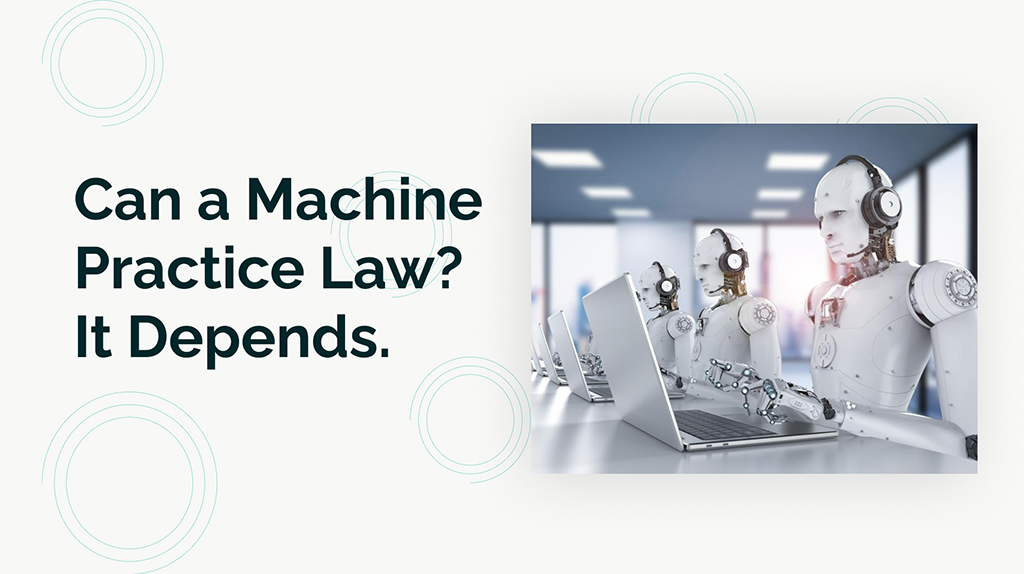Can a Machine Practice Law? It Depends.

Machines can’t practice law.
The statement is apparently obvious, but it’s implications are not:
In 2015, the court in Lola v. Skadden (linked here) affirmed the parties’ determination that “an individual who . . . undertakes tasks that could otherwise be performed entirely by a machine cannot be said to engage in the practice of law.”
The key here is the understanding of what constitutes a task “that could otherwise be performed entirely by a machine.”
In 2015 this meant document review.
But that definition will only expand as new tech continues to automate an increasing portion of legal work (see e.g., Clearbrief, Draft Builders, Briefpoint, etc.).
In 2022, companies are already working on facilitating end-to-end litigation document automation. Once they do, what’s left for the practice of law?
Certainly things like depositions, court appearances, client interviews, generating creative arguments, framing the facts in the light most favorable for their client, and anything else that requires the “black box of intuition.”
Will this change what you can bill a client for?
No – ABA Rule 1.5 permits billing for tasks necessary to conduct your representation and does not require that the activity constitute “the practice of law” (see e.g., billing for travel).
The major implication I predict is the proliferation of things like Arizona’s Alternative Business Structures – business entities that provide legal services and include nonlawyers with economic interests or decision-making authority.
If successful, this structure might look a lot like the relationship between doctors’ officers and their PAs: lawyers work over an office of paralegals conducting routine legal work and providing low-level legal advice.
And I think the potential pitfalls are similar too: an inexperienced paralegal’s bad advice may fall to the lawyer to fix, as is sometimes the case with doctors and PAs.
What does this ruling say in light of Upsolve?
By way of brief background, the Upsolve case involved Upsolve’s (an MGLD company) generation and provision of Chapter 7 filing documents to non-attorney petitioners. (See Briefpoint’s full article on the Upsolve case here). There, the court found that the company had engaged in the unauthorized practice of law because, among other things, it provided a finite number of legal options through which the petitioner-user could use Upsolve to draft their petition.
While non-binding, Upsolve’s underlying facts are meaningfully different than those in Lola v. Skadden because Lola v. Skadden involved the automation of documents for attorneys – not pro se litigants.
To recall the doctor analogy: while a pharmaceutical company may provide doctors with a medical “short-cut” for healing a patient, they do not themselves prescribe the medication to the patient – or even offer a finite amount of potential treatments for the same. Similarly, while an MGLD may provide attorneys a “short-cut” for resolving their clients’ disputes, they should not themselves do the same for unlicensed consumers – at least not directly.
Indirectly, an MGLD company may get around “unauthorized practice” by hiring licensed attorneys to stand-in as middlemen between the MGLD and the end-user (such is loosely the case with the Marble Law – an incredible company who’s similarly incredible vision would see the provision of legal services sold at transparent, flat rates).
Accordingly – and for now – it seems that Upsolve and Lola’s reconciliation stems from the end-user of the product: MGLD for attorneys = permissible, MGLD for non-attorneys = unauthorized.
Of course, life is never so cut-and-dry, this article does not constitute legal advice, and, if you are an MGLD company seeking guidance on what constitutes the practice of law, seek counsel.
Thank you for posting this informative post. Your opinions are very thought-provoking and the writing is very well articulated. Keep it up!
Appreciate you sharing this informative post. Your insights were very helpful and gained a lot of knowledge from it.